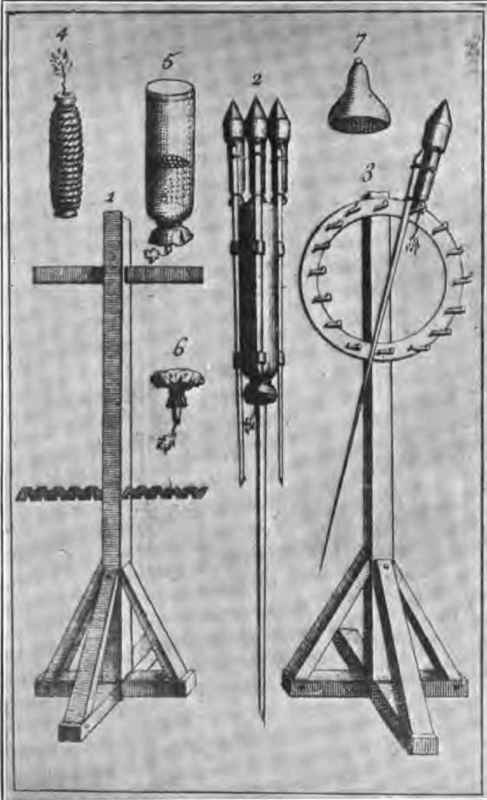Sticks
Description
This section is from the book "Military Pyrotechnics", by Henry B. Faber. Also available from Amazon: Military Pyrotechnics.
Sticks
The stick attached to a rocket serves to maintain it upright during flight. It acts as a counterbalance against the weight of the rocket. Thus, the action of the gases, from combustion within the air chamber of the rocket, is downward, and the resultant flight of the rocket is upward. (PL II, fig. 10.)
Plate II.

The lightest wood is best for these sticks. Those for rockets of 18 lines, or over, should be made of sawn pine. For smaller rockets, walnut, willow, and elm give excellent sticks.
The length of the stick should be at least eight times that of the rocket mold. The thickness in a square at one of the ends should be half the exterior diameter of the rocket. From that end which is attached to the rocket, the stick should diminish gradually in size to the other extremity, with its end one-eighth of the rocket's exterior diameter. (PL II, fig. 3.)
The greater the length of the stick, the more nearly vertical the ascent of the rocket. The stick can never be too long for this purpose, since, having its head only the size given above, it balances at a certain distance from the body of the rocket when this is attached. The distance is regulated by the exterior diameter of the rocket Two and one-half times the interior diameter of the rocket is the distance of the stick's balancing point from the body of the rocket for small rockets, up to and including those of twelve lines.
*
For the rockets of larger size, up to and including those of 2 inches, the distance of the stick's balancing point from the body of the rocket is two diameters. For those still larger, the distance is one and one-half diameters. Following these proportions, the stick of a 1-inch rocket should balance at 2 1/2-inches distance from the throat of the rocket. The equilibrium is tested by balancing thestick on a knife blade. If the stick is too light, it must be changed. When the error is slight, it may be rectified by fastening the rocket an inch or two higher on the stick. This gives greater length to the stick and consequently greater weight If the stick is too heavy, it must be taken from the rocket, and its thickness reduced. A groove is made in the stick at the point where the rocket is to be attached, in order to insure stability for the fastening. The large end of the stick should be beveled, both for the sake of a neat appearance and in order that it may offer less resistance to the air.
The rocket is placed in the groove, but with the ligature of the pot somewhat beyond the end of the stick. The rocket is secured in its place by cords, which catch in notches cut on the stick. The first cord passes around the stick and rocket a little below the beveled end of the stick; the second is attached at the point where the rocket is choked. These cords are tied with the knot of the artificer.
In England, some have entertained the idea of escaping accidents caused from the fall of large sticks by the use of substitutes for such sticks made from saucissons, of which the cases are playing cards. These saucissons are arranged in such a manner that one projects from another. The series is glued together in a straight line, and the ends are covered with bands of paper pasted on. Thus, the saucissons form one long, solid piece. Between each two of the saucissons, a small quantity of powder is contained, to set off the charge. A fuse which takes its fire from the rocket pot and communicates with all the saucissons, each of them being supplied with its individual fuse, gives them fire at the instant when the rocket casts out its garniture. The saucissons thus fulfill all the purposes of a stick for the rocket, and then finally are divided up into individual parts, which as they are consumed increase the beauty of the spectacle.
Racks
The rocket rack is merely a post set in the ground, or sustained in position by means of a base having the form of a cross. It is traversed at the top by a bar of iron, on which the rockets are placed one after another for firing. (PL III, figs. 1 and 3.)
Plate III.

Such racks have several forms, but the simplest is also the most convenient, since it may be transported easily. This is simply a pole, equipped at its lower end with an iron point, and at the other with a long screw on which to hang the rocket for firing.
It is necessary to unbonnet the rocket, by breaking the paper cover over the throat with a stroke of the thumb-nail after the rocket has been placed in position on the rack. For kindling, a wick is used, which is held by an iron device on the end of a light stick about 5 feet in length. A ring attachment serves to lengthen or shorten the projection of the wick.
Continue to:


